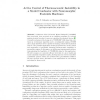Free Online Productivity Tools
i2Speak
i2Symbol
i2OCR
iTex2Img
iWeb2Print
iWeb2Shot
i2Type
iPdf2Split
iPdf2Merge
i2Bopomofo
i2Arabic
i2Style
i2Image
i2PDF
iLatex2Rtf
Sci2ools
GECCO
2003
Springer
2003
Springer
Active Control of Thermoacoustic Instability in a Model Combustor with Neuromorphic Evolvable Hardware
Continuous Time Recurrent Neural Networks (CTRNNs) have previously been proposed as an enabling paradigm for evolving analog electrical circuits to serve as controllers for physical devices [6]. Currently underway is the design of a CTRNN-EH VLSI chips that combines an evolutionary algorithm and a reconfigurable analog CTRNN into a single hardware device capable of learning control laws of physical devices. One potential application of this proposed device is the control and suppression of potentially damaging thermoacoustic instability in gas turbine engines. In this paper, we will present experimental evidence demonstrating the feasibility of CTRNN-EH chips for this application. We will compare our controller efficacy with that of a more traditional Linear Quadratic Regulator (LQR), showing that our evolved controllers consistently perform better and possess better generalization abilities. We will conclude with a discussion of the implications of our findings and plans for future ...
| Added | 06 Jul 2010 |
| Updated | 06 Jul 2010 |
| Type | Conference |
| Year | 2003 |
| Where | GECCO |
| Authors | John C. Gallagher, Saranyan Vigraham |
Comments (0)

